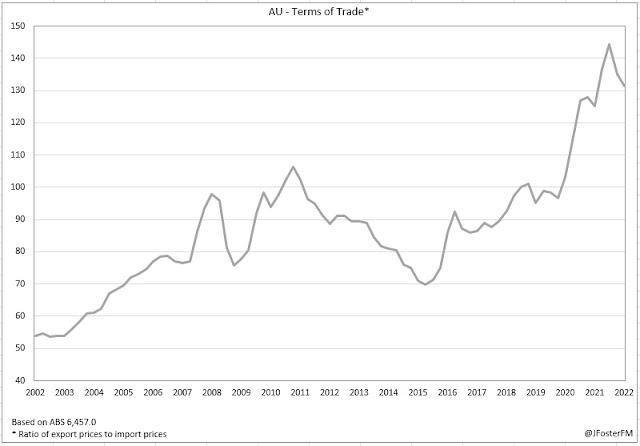Australia's trade surplus narrowed in December but remained at very elevated levels above $12bn. A substantial widening in the trade surplus over Q4 points to a rebound in the contribution to economic growth from net exports.
International Trade — December | By the numbers
- Australia's trade surplus narrowed to $12.2bn in December from $13.5bn in November (revised up from $13.2bn), coming in a bit lower than expected ($12.5bn).
- Exports posted a 1.4% fall in the month to $57.8bn, its third consecutive decline though earnings still advanced over the quarter (2.6%). Annual growth moderated from 29.3% to 24.8%.
- Imports saw a 1%m/m rise coming in at $45.6bn. Import spending declined in Q4 (-3.2%), as annual growth slowed to 18% from 24.5%.
International Trade — December | The details
Australia's trade surplus was narrower in December as exports declined and imports rose, though it widened substantially over the final quarter in 2022. The quarterly trade surplus was around $38bn from $29bn in Q3. Exports picked up to rise by 2.6% after falling in Q3, led by commodities. In contrast, import spending eased in Q4 (-3.2%) following a surge in Q3 (9.3%) reflecting falls in fuel prices and some easing of demand and pricing pressures in traded goods.
In December, the weakness in export earnings (-1.4%) mainly reflected a decline in non-rural goods (-2.6%) on broad-based falls in the major commodities: iron ore -3%, coal -1.8%, other mineral fuels (LNG) -5.6% and metals -15.4%. Rural goods also declined as earnings from meat (4.6%) and cereals (-6.4%) softened. The services sector made a neutral contribution to monthly exports and still remains in post-pandemic recovery mode, with tourism-related earnings still down by more than a third on end-2019 levels.
The rise in import spending (1%) in the month ended a run of three consecutive declines. The capital goods segment lifted more than 12% in the month on broad-based rises across industrial, communications and transport equipment. Car imports (part of consumption goods, which lifted 1.5%m/m) also advanced sharply (10.8%), collectively these gains are indicative of the easing of supply chain pressures that previously hampered production. Intermediate goods saw a 5.8% fall due largely to fuel (-10.4%) as prices continued to roll over from their recent highs.
Overseas travel during the peak holiday period in Australia picked up very sharply driving services imports to a 4.4% rise. Tourism-related spending was up more than 19% in the month, though the level was still 29% below where it was prior to the pandemic at the end of 2019.
International Trade — December | Insights
The elevation in the quarterly trade surplus was driven by rising exports and declining imports, pointing to a solid contribution to quarterly GDP from net exports. However, recent data on trade prices indicates that the terms of trade moved further below their recent high in Q4 reflecting declines in global commodity prices.







